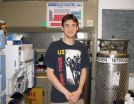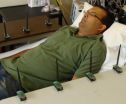(Press-News.org) ITHACA, N.Y. – With an eye toward understanding DNA replication, Cornell researchers have learned how a helicase enzyme works to actually unzip the two strands of DNA. (Nature, online Sept. 18, 2011.)
At the heart of many metabolic processes, including DNA replication, are enzymes called helicases. Acting like motors, these proteins travel along one side of double-stranded DNA, prompting the strands to "zip" apart.
What had been a mystery was the exact mechanics of this vital biological process – how individual helicase subunits coordinate and physically cause the unzipping mechanism.
Cornell researchers led by Michelle Wang, professor of physics and an investigator of the Howard Hughes Medical Institute (HHMI), have observed these processes by manipulating single DNA molecules to watch what happens when helicases encounter them, and how different nucleotides that fuel the reactions affect the process. For their experiments they used an E. coli T7 phage helicase, a type with six distinct subunits, which is a good representation of how many helicases work.
"This is a great demonstration of the power of single-molecule studies," said Wang, whose lab specializes in a technique called optical trapping. To record data from single molecules, the scientists use a focused beam of light to "trap" microspheres attached to the molecules.
Prior to this work, researchers from other labs had found that the nucleotide dTTP (deoxythymidine triphosphate) was a "preferred" fuel for the helicase, and that the helicase apparently wouldn't unzip DNA if ATP (adenosine triphosphate) was provided as fuel. Wang and her colleagues found this puzzling, because ATP is known to be the primary fuel molecule in living organisms.
In their latest work, they discovered that, in fact, ATP does cause unwinding, but only in the single-molecule study could they confirm this. In normal biochemical studies, ATP doesn't seem to work, because it causes helicase to "slip" backward on the DNA, then move forward, then slip again.
In bulk studies, rather than single-molecule kinetic observations, the ATP doesn't produce a signal from unwound DNA because the slippage masks the signal.
They then surmised that different mixtures of nucleotides might allow them to investigate helicase subunit coordination. They found that very small amounts of dTTP mixed with large amounts of ATP were enough to decrease the "slippage" events they saw with the ATP alone.
Further inspection revealed that while two subunits of the T7 helicase are binding and releasing nucleotides, the other four can remain bound to nucleotides to anchor the DNA and prevent it from slipping. It only takes one subunit bound to dTTP to decrease slippage almost entirely – a little goes a long way.
Such studies can help scientists gain a deeper understanding of helicase mechanics and, in the case of medicine, what happens when helicases go awry or don't bind correctly.
Smita Patel, Rutgers University biochemistry professor and paper co-author, says helicase defects are associated with cancer predisposition, premature aging and many other genetics-related conditions.
"This study provides fundamental new knowledge about a cellular process that is essential to all forms of life," said Catherine Lewis, who oversees single-molecule biophysics grants at the National Institute of General Medical Sciences of the National Institutes of Health. "By using single-molecule methods to study how helicases work, Dr. Wang has resolved several longstanding questions about how the enzyme is coordinated, and possibly regulated, during replication."
###Along with contributions from researchers at other institutions, the paper's two lead authors are Bo Sun, an HHMI and Cornell postdoctoral associate in physics, and Daniel S. Johnson, a former graduate student.
The Nature paper, "ATP-induced helicase slippage reveals highly coordinated subunits," was funded by the National Institutes of Health, the National Science Foundation and the Cornell Molecular Biophysics Training Grant.
For unzipping DNA mysteries -- literally -- Cornell physicists discover how a vital enzyme works
2011-09-19
ELSE PRESS RELEASES FROM THIS DATE:
Gamers succeed where scientists fail
2011-09-19
Gamers have solved the structure of a retrovirus enzyme whose configuration had stumped scientists for more than a decade. The gamers achieved their discovery by playing Foldit, an online game that allows players to collaborate and compete in predicting the structure of protein molecules.
After scientists repeatedly failed to piece together the structure of a protein-cutting enzyme from an AIDS-like virus, they called in the Foldit players. The scientists challenged the gamers to produce an accurate model of the enzyme. They did it in only three weeks.
This class ...
U of T-led research improves performance of next-generation solar cell technology
2011-09-19
TORONTO, ON – Researchers from the University of Toronto (U of T), the King Abdullah University of Science & Technology (KAUST) and Pennsylvania State University (Penn State) have created the most efficient solar cell ever made based on collodial-quatum-dots (CQD).
The discovery is reported in the latest issue of Nature Materials.
Quantum dots are nanoscale semiconductors that capture light and convert it into an energy source. Because of their small scale, the dots can be sprayed on to flexible surfaces, including plastics. This enables the production of solar cells ...
Catching a breath -- wirelessly
2011-09-19
SALT LAKE CITY, Sept. 19, 2011 – University of Utah engineers who built wireless networks that see through walls now are aiming the technology at a new goal: noninvasively measuring the breathing of surgery patients, adults with sleep apnea and babies at risk of sudden infant death syndrome (SIDS).
Because the technique uses off-the-shelf wireless transceivers similar to those used in home computer networks, "the cost of this system will be cheaper than existing methods of monitoring breathing," says Neal Patwari, senior author of a study of the new method and an assistant ...
ADHD symptoms worsen quality of life for individuals with autism
2011-09-19
NEW YORK, N.Y. (September 18, 2011) – Research supported by the Autism Speaks Autism Treatment Network (ATN), demonstrating that symptoms of attention deficit and hyperactivity worsen quality of life for individuals with autism spectrum disorders (ASD), was presented today at the Society for Developmental & Behavioral Pediatrics Annual Meeting in San Antonio, Texas. Researchers Parul Vora, M.D., developmental-behavioral pediatric fellow at Nationwide Children's and Darryn Sikora, Ph.D., Director of the Autism Program at Oregon Health Sciences University, used data exclusively ...
Minimizing extinctions in a changing climate: New study
2011-09-19
More species could be saved from extinction under climate change thanks to a new model scientists have developed to guide allocation of conservation funding.
The international team, led by Dr Brendan Wintle of the University of Melbourne and the ARC Centre of Excellence for Environmental Decisions, is the first to develop a pioneering decision-support model that incorporates both ecological and economic information to guide conservation investment in the face of climate change. The work is published today [Monday 19 September] in the journal Nature Climate Change.
"The ...
We are not only eating 'materials', we are also eating 'information'
2011-09-19
In a new study, Chen-Yu Zhang's group at Nanjing university present a rather striking finding that plant miRNAs could make into the host blood and tissues via the route of food-intake. Moreover, once inside the host, they can elicit functions by regulating host "target" genes and thus regulate host physiology.
MicroRNAs are a class of 19-24 nucleotide non-coding RNAs that do not code for proteins. MicroRNAs bind to target messenger RNAs to inhibit protein translation. In previous studies, the same group has demonstrated that stable microRNAs (miRNAs) in mammalian serum ...
Study finds bidirectional relationship between schizophrenia and epilepsy
2011-09-19
Researchers from Taiwan have confirmed a bidirectional relation between schizophrenia and epilepsy. The study published today in Epilepsia, a journal of the International League Against Epilepsy (ILAE), reports that patients with epilepsy were nearly 8 times more likely to develop schizophrenia and those with schizophrenia were close to 6 times more likely to develop epilepsy.
Prior clinical studies have shown a prevalence of psychosis among epilepsy patients and studies of psychiatric illness have found a strong relationship between schizophrenia and epilepsy, suggesting ...
Causes of Gulf War Illness are complex and vary by deployment area -- Baylor University study
2011-09-19
Gulf War Illness (GWI)—the chronic health condition that affects about one in four military veterans of the 1991 Gulf War—appears to be the result of several factors, which differed in importance depending upon the locations where veterans served during the war, according to a Baylor University study.
Published online today in the journal Environmental Health Perspectives, the study investigated links between GWI and veterans' locations during the war. GWI was most prevalent in veterans who served in forward areas of Iraq and Kuwait, where it was most strongly associated ...
Size matters: Length of songbirds’ playlists linked to brain region proportions
2011-09-19
Call a bird "birdbrained" and they may call "fowl." Cornell University researchers have proven that the capacity for learning in birds is not linked to overall brain size, but to the relative size and proportion of their specific brain regions.
Songbirds with upper brain regions that are larger in relation to lower regions have a greater capacity for learning songs. Higher brain areas control the majority of cognitive and learning functions, while lower brain areas control more motor functions, according to the new study published in the Proceedings of the National Academy ...
Shake hands with the invisible man
2011-09-19
Like DNA, fingerprints are unique to each person or set of identical twins. That makes them a valuable identification tool for everything from crime detection to international travel. But what happens when the tips of our fingers are missing those distinctive patterns of ridges?
It's not the premise for a science fiction movie, but a real-life condition known as adermatoglyphia. It's also known as "Immigration Delay Disease," because affected individuals experience difficulty in passing through security or checkpoints where fingerprint identification is required. Now ...

